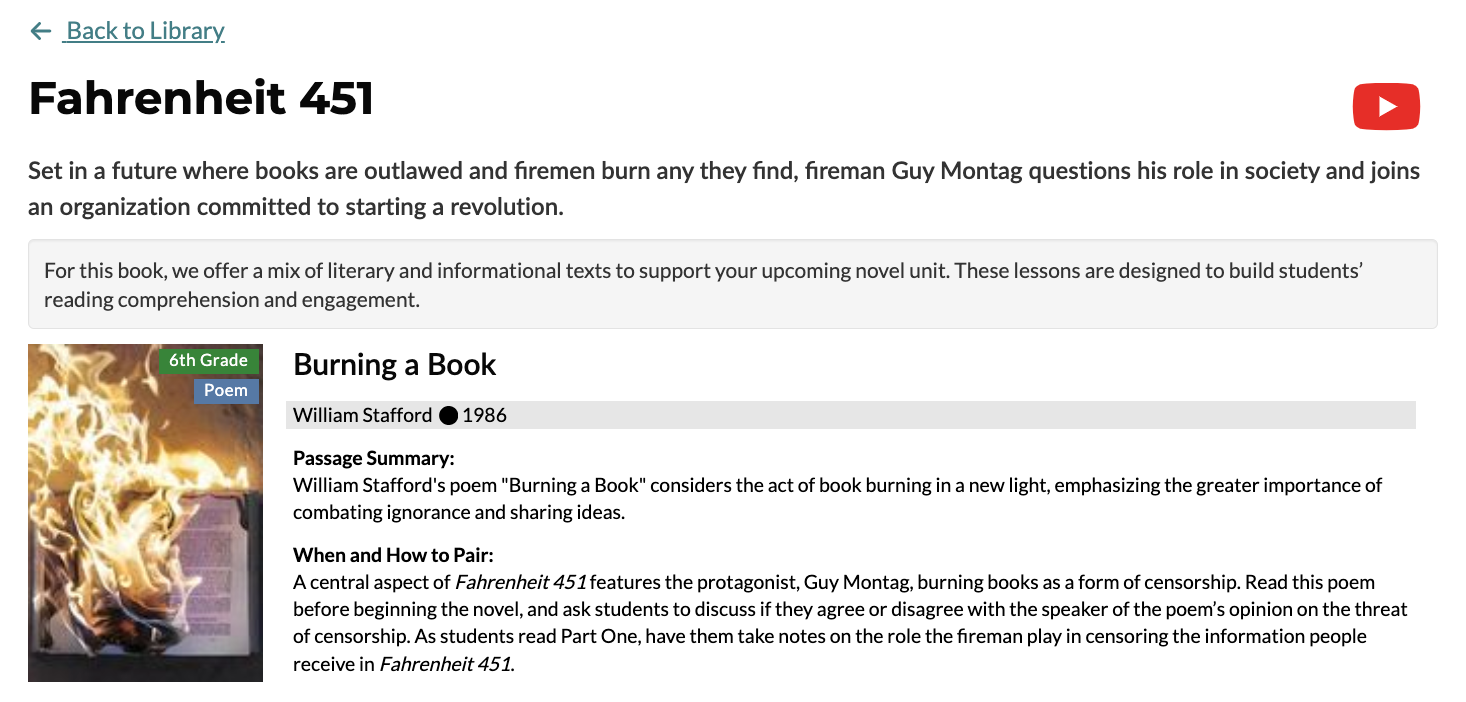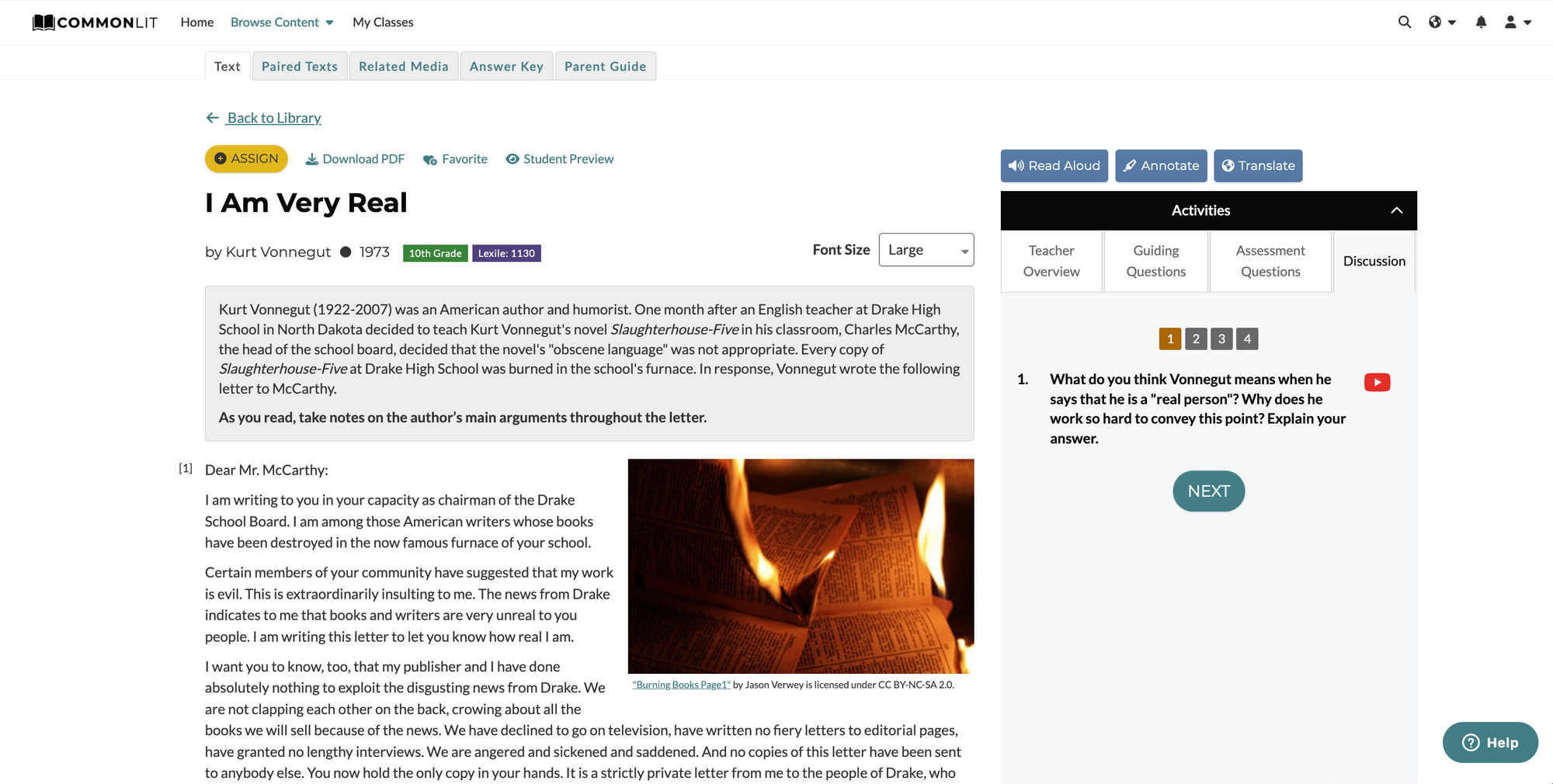 Secondary Classrooms
Heat Up Your Class Discussion Surrounding Fahrenheit 451 with these 7 Supplemental Texts
Secondary Classrooms
Heat Up Your Class Discussion Surrounding Fahrenheit 451 with these 7 Supplemental Texts
Explore fascinating dystopian themes and bolster student reading comprehension using CommonLit’s novel companion lessons.
CommonLit’s online literacy program offers thousands of detailed reading lessons. Additionally, teachers can find Book Pairings for over a hundred classic books taught in schools across the country. The lessons included in Book Pairings are designed to build students’ interest and reading comprehension. Each paired lesson includes background information and discussion questions that tie the novel and the supplemental passage together. Introduce book pairings to your ELA curriculum today!
Fahrenheit 451 by Ray Bradbury tells the story of Guy Montag, a man living in a dystopian future who works for the government burning books for a living. Slowly, he realizes that the books being burned hold knowledge, and keeping the books from the masses is a form of disenfranchisement. This thrilling novel will be sure to engage your class.

Understanding Fahrenheit 451 from a Psychological Perspective
These two informational articles and philosophical allegories explore aspects of the human condition that are relevant to Fahrenheit 451. Explore why characters are following the rules of a nonsensical government, and, using these informational texts as background information, discuss how this futuristic society was lulled into numbness through technology.
“Why do People Follow the Crowd?” by ABC News (9th grade)
Dr. Gregory Burns, a professor of behavioral science, conducted several experiments to study why humans readily conform. ABC's Primetime recreated these experiments using several unsuspecting people. The results showed that people are likely to adhere to the norms around them, even in the face of injustice.
After finishing Part One of Bradbury’s novel, ask students to use the background information from this article to analyze why the society in Fahrenheit 451 has, seemingly, welcomed a totalitarian government. What specific evidence from the article provides clues as to why people might not rebel?
“More Facebook Friends, Fewer Real Ones, Says Cornell Study” by ABC News (8th grade)
In this article, Matthew Brashears conducts a study that suggests social networks may not be fulfilling society's deeper social needs.
After reading the scene in Part Two where Guy Montag complains that his wife can no longer hold a conversation, ask students to analyze the author’s argument that technology has a negative effect on the characters’ lives in the novel. Compare and contrast the effect of modern-day social media with the impact of technology in the novel.
“Allegory of the Cave” by Plato (11th grade)
Plato's “Allegory of the Cave” is a piece of philosophy that explains the importance of knowledge, for both society and the human soul.
Fahrenheit 451 and this excerpt feature individuals that transition from ignorance to enlightenment. After finishing the novel, ask students to compare and contrast Montag’s path to enlightenment with the “Allegory of the Cave.”
Historical Examples of Censorship and Fear Mongering
Fahrenheit 451, like much dystopian literature, draws inspiration from historical events and totalitarian governments. These four texts show examples of authority figures using fear-mongering and censorship to control citizens.
“Burning a Book” by William Stafford (6th grade)
William Stafford's poem "Burning a Book" considers the act of book burning in a new light, emphasizing the greater importance of combating ignorance and sharing ideas.
A central aspect of Fahrenheit 451 is the act of burning books as a form of censorship. Read this poem before beginning the novel, and ask students if they agree or disagree with the poem’s view of censorship.

“I Am Very Real” by Kurt Vonnegut (10th grade)
This letter was written by Kurt Vonnegut, author Slaughterhouse-Five, to the head of the school board in Drake, South Dakota. The school board decided that the novel's "obscene language" was not appropriate for students. Every copy of Slaughterhouse-Five at Drake High School was burned.
Ask students to read this essay before starting Ray Bradbury’s book. Discuss what banning books in schools tells us about the society we live in. As students read Fahrenheit 451, have them keep track of what books and authors are referenced. Why would the author choose to mention those books and authors?
“The Salem (And Other) Witch Hunts” by Mike Kubic (11th grade)
In this informational text, Mike Kubic explores the Salem Witch Trials and various other witch hunts that have occurred throughout history.
Fahrenheit 451 and this article both feature individuals who are persecuted by their government for their beliefs. Prompt the class to consider why the government powers in the article and in Fahrenheit 451 persecute people for their beliefs.
“Total Control in North Korea” by Jessica McBirney (9th grade)
This article describes life in North Korea under totalitarian government rule. In North Korea, the government has total control over the economy, the military, the education systems, and access to information. The regime punishes citizens who try to change the status quo.
Both this article and the dystopian novel feature totalitarian governments that go to extreme measures to punish their citizens for dissenting against the government. After finishing Part 3, asks students to compare and contrast the way the totalitarian government in the article and Fahrenheit 451 coerce their citizens into obedience.
Next Steps
For more lessons about dystopian societies check out our Dystopian Literature Text Set.
If you’re interested in learning all about CommonLit’s free digital literacy program, join one of our upcoming webinars!

